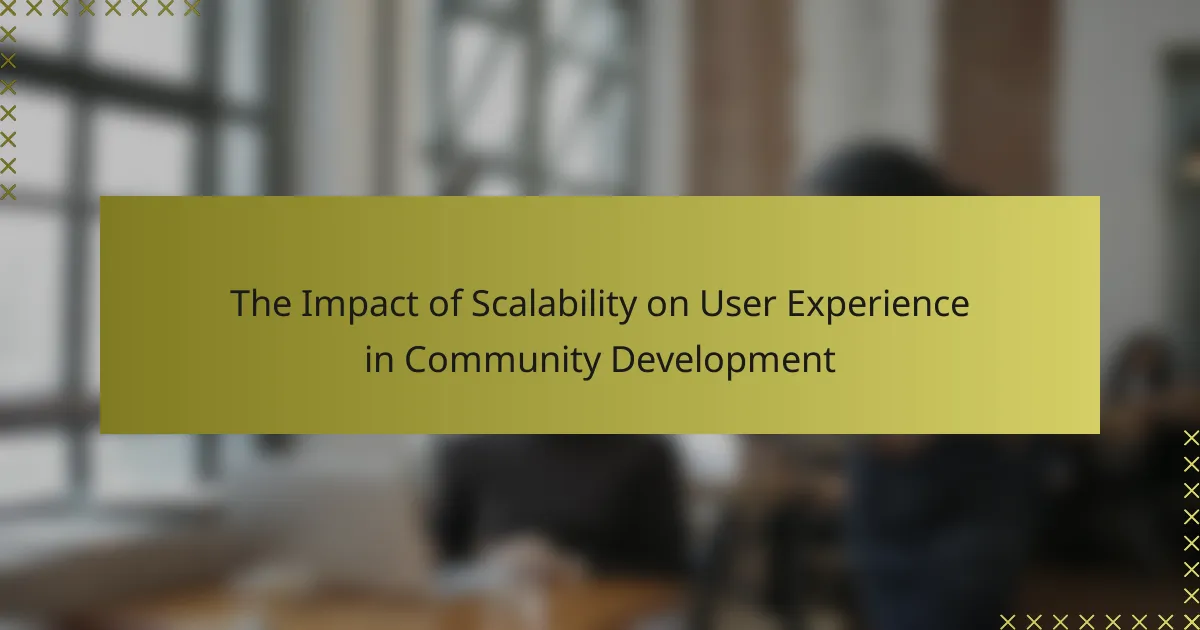Scalability plays a crucial role in shaping user experience within community development by enabling platforms to accommodate a growing user base while maintaining high performance. By implementing effective scalability strategies, such as cloud-based solutions and modular architecture, communities can enhance their infrastructure to support user engagement and satisfaction. However, as communities expand, challenges in resource management and quality preservation become increasingly significant, necessitating careful planning and execution.

How does scalability affect user experience in community development?
Scalability significantly impacts user experience in community development by ensuring that platforms can handle increasing numbers of users without sacrificing performance. A scalable system maintains efficiency and responsiveness, which are crucial for user satisfaction and engagement.
Improved performance and responsiveness
Scalability enhances performance by allowing systems to allocate resources dynamically based on user demand. For instance, during peak usage times, a scalable platform can distribute workloads across multiple servers, reducing latency and ensuring quick response times. This is particularly important in community development where user interactions can spike unexpectedly.
To achieve optimal performance, consider implementing cloud-based solutions that offer elastic scalability. This approach allows for automatic resource adjustments, ensuring that users experience minimal delays, typically in the low tens of milliseconds, even as the community grows.
Enhanced user engagement and satisfaction
When a community development platform is scalable, users are more likely to remain engaged due to a seamless experience. Fast load times and reliable access encourage users to participate actively, fostering a vibrant community. High engagement often translates to higher satisfaction levels, as users feel their needs are being met efficiently.
To enhance user satisfaction, focus on intuitive design and responsive features that accommodate varying user loads. Regularly gather feedback to identify potential bottlenecks and address them proactively, ensuring that the user experience remains positive as the community expands.

What are effective scalability strategies for community development?
Effective scalability strategies for community development focus on enhancing infrastructure and processes to accommodate growth without compromising user experience. Key approaches include leveraging cloud-based solutions and adopting modular architecture to ensure flexibility and responsiveness.
Cloud-based solutions like Amazon Web Services
Cloud-based solutions, such as Amazon Web Services (AWS), provide scalable resources that can adjust to the needs of a growing community. These platforms allow for on-demand access to computing power, storage, and applications, enabling organizations to efficiently manage increased user loads.
When implementing AWS, consider using services like Elastic Load Balancing and Auto Scaling to automatically adjust resources based on traffic. This ensures that your community platform remains responsive during peak usage times, enhancing user satisfaction.
Modular architecture for flexibility
Modular architecture involves designing systems in separate, interchangeable components, allowing for easier updates and scalability. This approach enables community developers to add or modify features without overhauling the entire system, which can be time-consuming and disruptive.
For effective modular design, prioritize clear interfaces between components and maintain documentation for each module. This practice not only facilitates smoother upgrades but also helps in troubleshooting and enhances collaboration among development teams.

What are the challenges of scalability in community development?
Scalability in community development presents challenges primarily in resource management and maintaining quality as the community grows. As communities expand, ensuring that resources are allocated effectively while preserving the core values and standards becomes increasingly complex.
Resource allocation and management
Effective resource allocation is critical for scalable community development. As the community grows, the demand for resources—such as funding, personnel, and infrastructure—also increases. It’s essential to assess current resources and project future needs, often requiring a flexible budget that can adapt to changing circumstances.
Utilizing tools like project management software can help track resource distribution and identify gaps. Regular audits and feedback loops are also beneficial to ensure resources are being used efficiently and effectively.
Maintaining quality during growth
As communities scale, maintaining quality becomes a significant challenge. Rapid growth can lead to diluted standards and inconsistent experiences for members. Establishing clear guidelines and quality benchmarks is crucial to ensure that new initiatives align with the community’s core values.
Implementing training programs for new members and volunteers can help uphold quality. Additionally, soliciting regular feedback from community members can provide insights into areas needing improvement, allowing for timely adjustments to maintain high standards.

How can community developers measure scalability impact?
Community developers can measure the impact of scalability by evaluating user experience metrics and system performance. This involves gathering data through user feedback and utilizing performance analytics tools to assess how well the community platform adapts to increased user activity.
User feedback and surveys
User feedback is crucial for understanding how scalability affects the community experience. Developers can use surveys to gather insights on user satisfaction, response times, and overall engagement levels during peak usage periods.
To effectively collect feedback, consider using targeted questions that address specific aspects of scalability, such as loading times or accessibility during high traffic. Aim for a response rate of at least 20-30% to ensure the data is representative of the user base.
Performance analytics tools
Performance analytics tools provide quantitative data on how a community platform performs under various loads. These tools can track metrics such as server response times, error rates, and user session durations, helping developers identify bottlenecks.
When selecting analytics tools, look for those that offer real-time monitoring and historical data comparison. Popular options include Google Analytics, New Relic, and Datadog. Regularly review this data to make informed decisions about infrastructure improvements and scalability strategies.

What role does technology play in scalability for communities?
Technology is crucial for enhancing scalability in community development, as it enables efficient resource management and user engagement. By leveraging digital tools, communities can adapt to growing needs while maintaining a positive user experience.
Utilization of AI for personalized experiences
Artificial Intelligence (AI) can significantly enhance user experiences by providing personalized interactions based on individual preferences and behaviors. For instance, AI algorithms can analyze user data to recommend relevant content or services, thereby increasing engagement and satisfaction.
Communities should consider implementing AI-driven chatbots for instant support or tailored notifications that keep users informed about events and opportunities. This approach not only improves user retention but also fosters a sense of belonging among community members.
Integration of social media platforms
Integrating social media platforms into community development can greatly enhance scalability by facilitating communication and collaboration among users. Social media allows for real-time updates and discussions, making it easier for members to connect and share resources.
Communities should focus on creating dedicated social media groups or pages to streamline interactions and promote events. Additionally, leveraging social media analytics can help community leaders understand user engagement trends and adjust strategies accordingly, ensuring a more responsive and dynamic environment.

How can community developers ensure sustainable scalability?
Community developers can ensure sustainable scalability by adopting strategic planning and flexible frameworks that accommodate growth. This involves anticipating user needs and resource demands while maintaining a focus on user experience.
Implementing best practices in project management
Effective project management is crucial for scalability in community development. Utilizing methodologies like Agile or Scrum can help teams adapt quickly to changing requirements and user feedback. Establishing clear goals, timelines, and roles ensures that everyone is aligned and can respond efficiently to growth challenges.
Regularly reviewing project progress and incorporating stakeholder input can enhance the overall effectiveness of the project. Tools like Gantt charts or Kanban boards can visually track progress and facilitate communication among team members.
Continuous training and development for teams
Investing in continuous training for teams is essential to maintain scalability. As community needs evolve, developers must stay updated on the latest technologies and methodologies to effectively address these changes. Workshops, online courses, and industry conferences can provide valuable learning opportunities.
Encouraging a culture of knowledge sharing within the team can also enhance skills and foster innovation. Regular team meetings to discuss new trends or challenges can help identify areas for improvement and ensure that the team is well-equipped to handle growth.

What are the future trends in scalability for community development?
Future trends in scalability for community development focus on enhancing user experience through innovative technologies and design principles. As communities grow, the need for efficient, user-friendly platforms becomes essential to accommodate diverse user needs and interactions.
Adoption of decentralized technologies
Decentralized technologies, such as blockchain and peer-to-peer networks, are becoming increasingly important in community development. These technologies enable greater transparency, security, and user control, which can significantly enhance user experience. For example, a community platform using blockchain can ensure that user data is secure and that transactions are verifiable without a central authority.
When implementing decentralized solutions, consider factors like network speed and user accessibility. While decentralized systems can offer robust security, they may also introduce latency issues, so it’s crucial to balance security with performance. Communities may need to invest in education to help users understand and navigate these technologies effectively.
Focus on user-centric design principles
User-centric design principles prioritize the needs and preferences of community members, leading to more engaging and effective platforms. This approach involves gathering user feedback, conducting usability testing, and iterating on designs based on real-world usage. For instance, a community app that allows users to customize their interface can enhance satisfaction and encourage participation.
To implement user-centric design, consider creating user personas and mapping user journeys to identify pain points. Regularly solicit feedback through surveys or focus groups to ensure the platform evolves with user needs. Avoid common pitfalls such as overcomplicating features or neglecting mobile optimization, as these can detract from the overall user experience.



